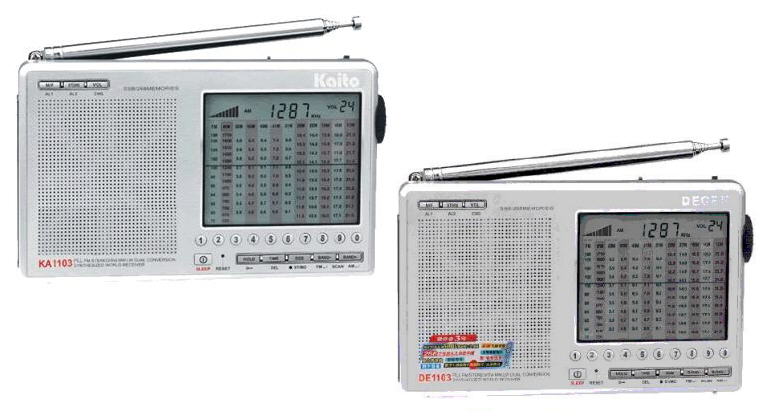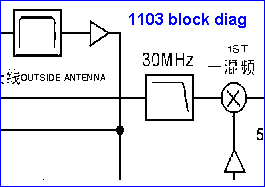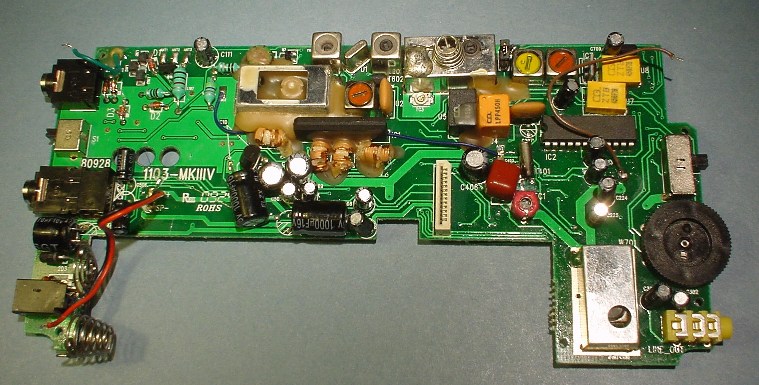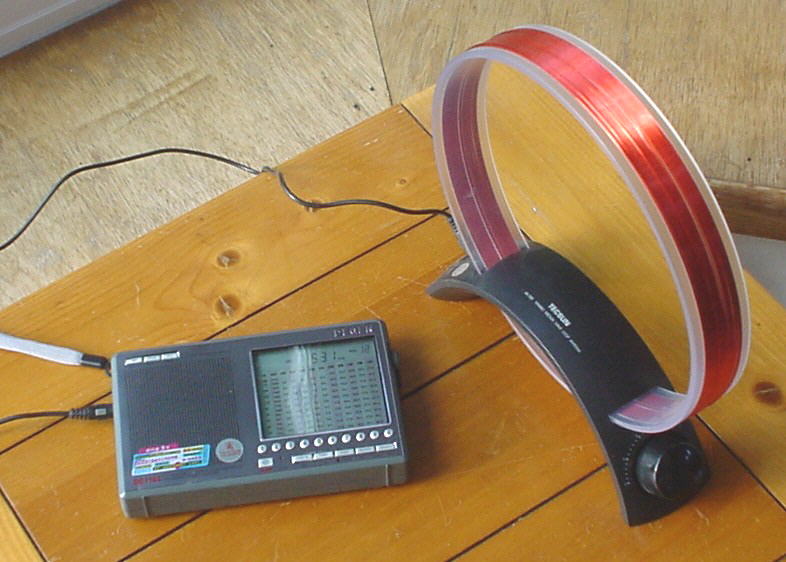
which may be of help in choosing a compact portable receiver
The 1103 receivers were introduced in about 2003-4, and have been sold under both the Degen and Kaito marques of the Tecsun Group in China. They are tiny and, it has to be said, really rather beautiful

They offer many facilities, as detailed on the various review pages below, but some of the more interesting features are less well-known, and the schematics will be of interest to anyone with a technical interest in receivers.
Out of the box, they offer an AM/SSB tuning range of 100kHz to 30MHz in 1kHz steps, using either the 0.9m whip aerial or an external aerial for HF, and the ferrite loop aerial for MW & LW. However a software 'Easter-egg trick' is available to extend the tuning range down to 1kHz and to allow the use of the whip or external antenna below 1710kHz.

In addition to the usual things you'd expect of an all-band portable, the 1103 has both rotary control and direct frequency entry, line and headphone output, external antenna socket, a rudimentary 4-segment signal-strength meter and battery indicator, and a timed battery charger for use with rechargables. Which reminds me...
BATTERY LIFE
Battery life is typical of a digitally-tuned radio, with current drain of 60mA (quiescent) rising to about 100mA for loud music. However, use of rechargables gives a disappointingly short play-time because the low-voltage cut-out operates at about 4.9V which is a poor situation when using a battery of nominally 5.0V. So, expect a couple of hours from newly-charged 2300mAH NiMH's!
The battery indicator can be invoked with the set 'off' by using the 'Chg' button, or with the set 'on' by using the 'M/F' button followed by 'Vol (Chg)'
The meter steps are approximately: 2 bars at 4.6V, 4 bars at 4.85V, 6 bars at 5.15V, 9 bars at 5.4V.

CIRCUIT DESIGN
Unusually for a portable AM/FM radio, the AM system uses an up-conversion configuration with an untuned antenna input, almost identical to earlier communication receivers like the John Thorpe -designed Lowe HF-125: see the HF-125 block diagram and compare with the 1103 block diagram
The same configuration was used in earlier Japanese portable receivers, including Sony models such as the ICF-SW77, ICF-7600D and Panasonic models such as the RF-B45 & B65. The 1103 in fact bears such a close resemblance to the B45/65 in the RF section that it looks as though there may have been some transfer of the design: RF-B65 block diagram
Panasonic radios production was later contracted out to Sangean, and one wonders if any of the engineers went to work for Tecsun at some stage...
I am told that the 1103 main PCB is also used in the Eton E5 and Grundig G5. The early RF PCBs were marked "1103_mainPCB", later ones with a few changes are marked "1103MKIIIV"

The 1st LO PLL tunes in 2kHz steps, the 2nd LO providing the 1kHz interpolation steps
In order to provide full coverage of 100-1710kHz with the ferrite rod antenna, the rod is aperiodic, working into a high-z jFET buffer with a negative-feedback winding on the rod. As a consequence the 1103 has lower LW sensitivity than most simple portables, and suffers from image responses due to the wideband rod plus the rather indifferent wideband rejection of the 55.845MHz 'roofing' filter. This unusual wideband ferrite-rod arrangement appears also in the Panasonic RF-B45, which however achieves higher LW sensitivity, with a rod of the same size as the 1103, by using an additional matching transformer,
I don't know how the ferrite rod tuning is accomplished in other radios using this upconverting RF system, such as the ICF-7600D and the Sony ICF-SW77 which achieves exceptional ferrite-rod sensitivity in the range 150 - 1709kHz. The only other way would be to tune the rod with varicaps driven from a lookup table + DAC.
On FM, the tuning range includes the Japanese FM band, down to 76MHz with 25kHz steps, and the LO is, unusually for a Band II receiver, low-side in order to avoid image problems from Band II. An external antenna can be connected to the antenna socket, except on early models. Using headphones, the stereo quality is excellent, and in this respect it is an ideal receiver for travelling.

The power adaptor is supplied either for 115V or 230V and is a good, heavy, and QRN-FREE transformer type. You may need to buy a plug adaptor to suit your mains power sockets.
The dealer Liypn of eBay Shop V-Com Collections, as well as selling the receivers, offers a few accessories for the 1103's. A padded imitation leather case, replacement telescopic antenna, and two loop antennas which can be used with these or other portable radios. The Tecsun AN-200 (also marketed by Grundig) is a small passive loop, manually-tunable over the range 510 - 1800kHz. The Degen 31MS is a hanging-wire single-turn active untuned (amplified) loop antenna for MW + SW (3.9 - 22MHz), with a jack lead and a ferrite-loop coupling coil so it can be used either with receivers having an antenna connector or those with only an internal ferrite antenna and/or telescopic antenna.
DRAWINGS
Zipped files of the schematic diagrams are available here
Datasheets for IC's LC72137,TA7358 and TA2057N
MODIFICATION
On FM the IF bandwidth is rather too wide for weak-signal reception. The two ceramic IF filters are commonly changed for narrow types by FD-DX enthusiasts, giving impressive weak-signal FM reception. Two of the now obsolete 80kHz types gives very good 'dx' performance at some slight loss of audio quality, or two 110kHz types will give a good compromise between dx and audio quality.
Changing filters should be attempted only if you are skilled at soldering and have a fine-bit solder iron. The cerafils are conventional through-hole types and can be removed without access to the rear of the PCB if you break the unwanted filters with side-cutters, leaving the leads projecting from the board. Solder the new filters to the old leads, cutting old and new leads for a compact fit
LINKS
Review from www.radioscanner.ru
Review from Dave's Radio Receiver Page
Article about the DE-1103 from Canada's original Worldband radio website
Thanks to Stephan Grossklass for technical details of the RF-B65, and receivers from other manufacturers
J.Hardstone 2008 - Last updated Nov..2014
